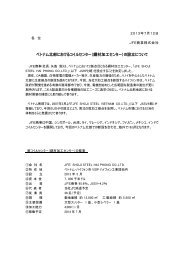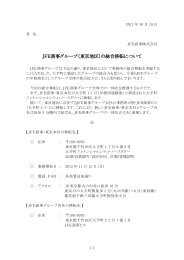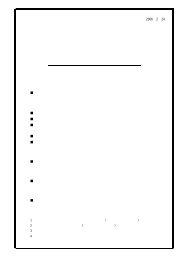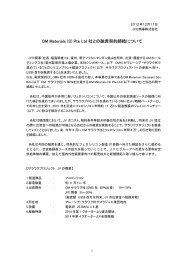Annual Report 2004 [PDF/1.1MB]
Annual Report 2004 [PDF/1.1MB]
Annual Report 2004 [PDF/1.1MB]
Create successful ePaper yourself
Turn your PDF publications into a flip-book with our unique Google optimized e-Paper software.
c. Cash and Cash Equivalents<br />
For the purposes of the consolidated statements of cash flows, cash and cash equivalents consist of cash on hand,<br />
deposits with banks withdrawable on demand, net of overdrafts, and all highly liquid short-term investments which are readily<br />
convertible to cash subject to an insignificant risk of any changes in their value and which were purchased with an original<br />
maturity of three months or less.<br />
d. Investments in Securities<br />
The accounting standard for financial instruments requires that securities be classified into three categories: trading, held-to<br />
maturity or other securities. Under this standard, trading securities are carried at fair value and held-to maturity debt<br />
securities are carried at amortized cost. Marketable securities classified as other securities are carried at fair value with<br />
any changes in unrealized holding gain or loss, net of the applicable income taxes, included directly in shareholders' equity.<br />
Non-marketable securities classified as other securities are carried at cost. Cost of securities sold is determined principally<br />
by the moving average method.<br />
e. Inventories<br />
Inventories are stated principally at cost determined by the moving-average method.<br />
f. Derivatives<br />
Derivative financial instruments are stated at fair value.<br />
g. Property and Equipment<br />
Property and equipment are carried at cost, except that one affiliate has revalued its land pursuant to the laws on land<br />
revaluation.<br />
Depreciation is computed by the declining-balance method over the estimated useful lives of the assets except for those<br />
held by certain consolidated subsidiaries which apply the straight-line method. The straight-line method is applied to buildings<br />
acquired subsequent to April 1, 1998.<br />
h. Allowance for Doubtful Receivables<br />
The Company and its domestic consolidated subsidiaries provide an allowance for doubtful receivables at the estimated<br />
aggregate amount of probable bad debts plus an amount calculated based on their historical experience of bad debts.<br />
The overseas consolidated subsidiaries provide an allowance for doubtful receivables at the estimated aggregate amount of<br />
probable bad debts.<br />
i. Accrued Retirement Benefits<br />
Accrued retirement benefits for employees have been provided mainly at an amount calculated based on the retirement<br />
benefit obligation and the fair value of the pension plan assets as of balance sheet dates, as adjusted for the unrecognized<br />
net retirement benefit obligation at transition, unrecognized actuarial gain or loss, and unrecognized prior service cost. The<br />
retirement benefit obligation is attributed to each period by the straight-line method over the estimated years of service of<br />
the eligible employees. The net retirement benefit obligation at transition is being amortized principally over a period of 15<br />
years by the straight-line method.<br />
Actuarial gain and loss are amortized in the year following the year in which the gain or loss is recognized primarily by the<br />
straight-line method over the average remaining years of service of the employees. Prior service cost is being amortized<br />
as incurred by the straight-line method over the average remaining years of service of the employees.<br />
See Note 6 for the method of accounting for the separation of the substitutional portion from the corporate portion of the<br />
benefit obligation under Welfare Pension Fund Plan.<br />
41


![Annual Report 2004 [PDF/1.1MB]](https://img.yumpu.com/28997981/40/500x640/annual-report-2004-pdf-11mb.jpg)






![Annual Report 2002 [PDF/1.6MB]](https://img.yumpu.com/44293603/1/190x248/annual-report-2002-pdf-16mb.jpg?quality=85)




